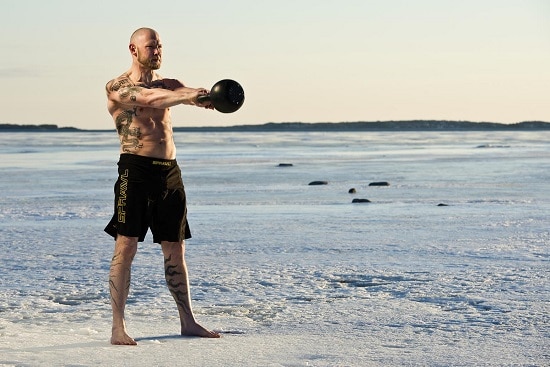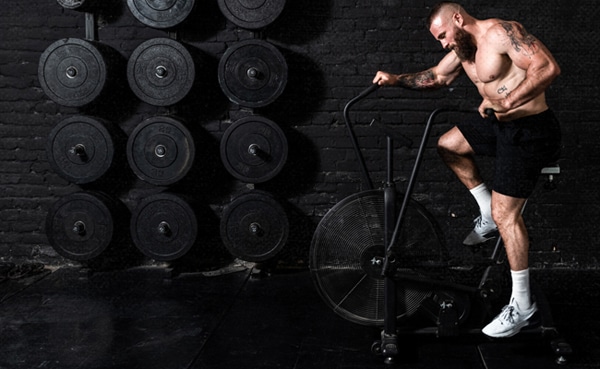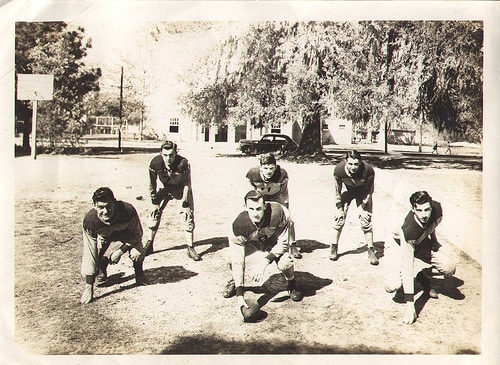
I’m a big fan of getting strong.
Physical strength improves all areas of life, and hoisting heavy weights is just plain fun. At least, I think it’s fun.
When I first embraced the gospel of the barbell with the zeal of a new convert seven years ago, I pretty much gave up on any cardio exercise, both the low-intensity and the high-intensity kind.
I rationalized my neglect of cardio by telling myself, “It gets in the way of my gains, bruh.”
Honestly, I just didn’t like doing cardio.
I’d never been into slow and steady exercise. Running and biking? Boring! I liked to ruck, but I tended to half-ass it. It never seemed like enough of a workout. That wasn’t rucking’s fault; it was my own.
And high-intensity cardio, like sprints and burpees and the like, just reminded me of the unpleasant parts of playing high school football.
I’d half-heartedly do high-intensity cardio at the end of my barbell workouts since my coach, Matt Reynolds, programmed it for me. But I always approached it as “Do it if you can get to it.” And I found myself finding reasons to skip out on these cardio sessions more often than not.
What was the result of my neglecting cardio?
A couple things. Neither of them good.
First, I got kind of chonky. Strong, but pudgy.
Second, I started getting winded doing everyday things. Sure, I could take a long hike on a backpacking trip, but I’d need to take more breaks than I would have liked. Intense games of ultimate frisbee left me sucking wind and asking for extended timeouts to catch my breath.
In short, I was out of shape.
I lacked conditioning.
During the past year, I’ve shifted my focus from just concentrating on pure strength to also investing in my conditioning. Matt has been with me 100% on this shift and has helped me stay strong as I’ve developed the other aspects of my fitness.
The results have been stellar.
I’m trimmer and in the all-around best shape I’ve been in in a long time. And the fact that I’ve been feeling so good, has changed my feelings about cardio.
To help us unpack the wonders of conditioning and how to do it, I consulted with Nick Solyen at Barbell Logic for his insight and advice.
What Is Conditioning, Anyway?
“Conditioning” is a word that gets thrown around a lot in the fitness world.
If you played football, the guy in charge of the team’s athletic performance was probably called a “strength and conditioning coach.”
If you’ve done CrossFit, you may have done “metabolic conditioning,” or “met-con,” workouts.
We all likely have a general idea of what conditioning means, that it has to do with cardiovascular fitness and that it’s training that gets you ready for some kind of event, i.e., you do gassers in basketball practice so that you won’t be gassed in a game.
That lay understanding of conditioning is a good starting point, but there’s more to it.
To understand conditioning, it helps to understand the body’s energy systems. We’ve discussed this in previous articles before, but it’s helpful to review.
All cells in your body are fueled by adenosine triphosphate, or ATP. When you walk, you’re using ATP. Deadlifting? Powered by ATP. Reading this article? ATP.
ATP can be produced in three ways:
- Through oxygen-dependent metabolism that utilizes fatty acids (oxidization). This is how most of the ATP you use throughout the day is created. When you breathe, oxidation turns fatty acids into ATP. Oxidation creates a lot of ATP. You get a lot of bang for your buck. Oxidation occurs within your cells’ mitochondria.
- Through non-oxygen-dependent glucose metabolism (glycolysis). If you’re doing an intense exercise like sprinting or lifting weights, your body switches from oxidizing fatty cells to produce ATP to burning glycogen/carbs to replenish ATP stores. Glycolysis produces large amounts of ATP but not as much as oxidation. Glycolysis doesn’t occur in your mitochondria but rather in your cells’ cytosol.
- Through the recycling of previously stored ATP. When ATP transfers energy to cells, it breaks off one of its phosphates and becomes adenosine diphosphate (ADP). Creatine then comes along and says, “Hey, ADP, you can have my phosphate,” turning it back into ATP to once more be utilized as energy. Creatine supplementation can help this process.
Which system we use to generate ATP depends on the intensity of the activity we’re engaged in.
Low-intensity activities like walking, slow jogging, and leisurely swimming primarily use fat to generate ATP. When your body is using fat for fuel, it’s called oxidation or aerobic activity since your body is using oxygen to help convert the fat to ATP.
As the intensity increases, you start using more carbohydrates. So if your slow jog turns into a speedier trot, your body starts using more carbs to generate the ATP your body needs to haul your carcass along the running trail. When your body uses carbs to create ATP, it’s called glycolysis. It’s also called anaerobic activity since it doesn’t use oxygen in the ATP creation process.
When you do an intense activity like sprinting or a heavy set of squats, your body uses creatine phosphate to create ATP. Like glycolysis, ATP created from creatine phosphate doesn’t use oxygen. Thus, activity that uses creatine phosphate for ATP is also called anaerobic.
When physiologists and fitness scientists talk about “conditioning,” they’re talking about your body’s ability to create energy using these aerobic and anaerobic systems. The more conditioning you have, the more efficient your body is at creating energy in a given metabolic system.
The Two Types of Conditioning: Aerobic and Anaerobic
You can have aerobic conditioning without anaerobic conditioning or vice versa. Ideally, you’ll have both.
Aerobic Conditioning
Aerobic conditioning refers to your body’s ability to use oxidation to create ATP. The better your aerobic conditioning, the more efficient your body is at creating ATP from fat.
The best way to improve your aerobic conditioning is to engage in regular bouts of long Zone 2 cardio sessions. Zone 2 cardio involves exercising with your heart rate within a certain range, and we’ve got a full guide to doing it here. Not only does Zone 2 cardio help your cells use fat for fuel more efficiently, but it also helps create more mitochondria, which are the powerhouses in that conversion process. The more mitochondria you gain, the better your body becomes at turning fat into fuel.
Besides improving your body’s ability to use fat for fuel, aerobic conditioning, like Zone 2 cardio, improves cardiovascular health, aids recovery, and boosts mood. It also helps with body composition. You burn a lot of calories when you take part in long sessions of Zone 2 cardio, which helps reduce body fat. I’ve become a lot leaner since adding Zone 2 cardio to my workout routine.
Anaerobic Conditioning
Anaerobic conditioning refers to your body’s ability to use glycogen or creatine phosphate to create ATP. The more anaerobic conditioning you have, the more efficient your body is at creating ATP from glycogen or creatine phosphate.
You condition or train your anaerobic systems by performing short bursts of intense activity. Trainers call the type of workout protocol designed to work the anaerobic system high-intensity interval training, or HIIT.
Vigorously pedaling an assault bike, swinging battle ropes, pushing a weighted sled, performing bodyweight circuits, and doing wind sprints are all examples of exercises that condition your anaerobic systems. Any activity can be turned into anaerobic conditioning as long as you do it with maximum effort.
Besides improving your body’s ability to create ATP from glycogen or creatine phosphate, anaerobic conditioning also generates other benefits. Research shows that your body continues to burn calories even after you’ve done a HIIT workout, so if trimming up is on your list of goals, you need to get winded a few times a week.
HIIT has also been shown to improve insulin resistance which can help mitigate things like type 2 diabetes.
Besides improving your body’s ability to create energy from glycogen or creatine phosphate, HIIT strengthens muscles and joints, helps stave off dementia, and boosts your mood.
Programming Conditioning for Everyday Life
According to Nick, a good general conditioning program seeks to develop both your aerobic and anaerobic systems while allowing you to train for strength.
You might be thinking, “How am I going to strength train and do aerobic and anaerobic conditioning? I’ve only got so much time in the week!”
It’s actually pretty easy.
Nick suggests the following regimen. Modify it based on your specific circumstances.
Aerobic Conditioning (At least 5 hours a week)
Nick recommends getting in at least five hours of low-intensity aerobic conditioning a week.
Walking, jogging, cycling, and rucking are great aerobic conditioning activities. They’re the type of thing you could do every day without it wearing you out or getting in the way of your strength training.
There are different ways to accumulate your five weekly hours of aerobic conditioning. For many guys, it will mean just trying to get in an hour of brisk walking each day. Try breaking that hour into four 15-minute walk breaks you distribute throughout your schedule. Make phone calls while on your walks if you want to multitask. Bam! That’s an hour of daily aerobic activity right there.
My aerobic conditioning looks like this:
Walk as much as I can throughout the day, every day.
Wednesday, Saturday, and Sunday: Hour-long sessions of Zone 2 cardio done by pedaling an elliptical machine or walking on an incline treadmill.
For me, discovering the Zone 2 sweet spot — a mode of exercise that is hard enough to work up a satisfying sweat but not so hard as to induce stress and depletion (and which allows me to watch a guilt-free hour of Cobra Kai) — has changed my whole opinion of cardio. It’s gone from something I avoided, to something I look forward to.
Anaerobic Conditioning (2 short sessions a week)
According to Nick, to get the benefits of anaerobic conditioning, it needs to have 1) high enough intensity to elicit an adaptive response from your anaerobic system, and 2) high enough volume to have a meaningful effect.
If you can still talk when you’re doing what you think is your anaerobic exercise, you’re not doing anaerobic exercise. It’s not intense enough.
If all you do is a single, full-out wind sprint for your anaerobic conditioning, that’s not enough volume for your anaerobic conditioning to do anything for you.
To ensure you get the intensity and volume right, Nick suggests the following anaerobic conditioning programming to get started:
- Pick your anaerobic activity. Here are some suggestions: fan bike, jump rope, battle ropes, kettlebell swings, sprints, burpees, sled pushing.
- Do a 20-second interval of your chosen activity, going as hard as possible. If you’re doing this right, Nick says, you should look like “a crazy person pedaling away from a rabid grizzly.”
- Rest for 1 minute and 40 seconds.
- Repeat for two to four more intervals.
That’s it! A beginner HIIT workout like this only takes about five minutes and gives you the appropriate dose and volume for anaerobic conditioning.
As you get more and more anaerobically conditioned, you’ll need to increase the stress of your HIIT workouts, so you continue to elicit an adaptive response. Nick recommends adding stress to your HIIT workouts in three ways:
- Add rounds. If you completed three rounds on day 1, try to do four next time. Then, add one round per week. Shoot for eight to twelve rounds before changing one of the other variables (rest or weight). Once you do so, drop back to four to six rounds and repeat the process.
- Decrease your rest time. Start with a 1:5 work-to-rest ratio. Twenty seconds of intense work followed by 1 minute and 40 seconds of rest will give you that 1:5 ratio. The following week, try going to a 1:4 work-to-rest ratio. That would be 20 seconds of work, followed by 1 minute and 20 seconds of rest. You know your rest is appropriate when you feel a downshift in your effort — a sudden decrease in power output — in the middle of your second to last interval. If you don’t feel that downshift, you’re either not working hard enough during your work intervals or taking too long of a rest interval. Do not, however, decrease your rest to less than a 1:3 ratio. If the intensity is appropriately high, anything less than a 1:3 work-to-rest ratio should not allow you to complete enough intervals for effective conditioning training.
- Add weight. Some HIIT-facilitating implements, like a pull/push sled, allow you to add weight — and thus intensity — over time. Make weight the last factor you manipulate, however. Conditioning training is much more dependent on the intensity of the work and the appropriate rest.
Even as you get more advanced with it, you only need to do HIIT workouts two times a week to get the anaerobic conditioning benefit. Nick recommends doing your HIIT workouts right after your strength training workout. You don’t want to do them before your weightlifting because it will sap your strength for the main workout.
I do my HIIT workouts after my barbell sessions — on my deadlift day and bench press day. On deadlift day, I’ll do a HIIT circuit focusing on my lower body. My favorite lately is alternating between kettlebell swings and bodyweight lunges in a circuit fashion. I’ll do the swings for 20 seconds, followed by 20 seconds of alternating lunges, followed by a rest of a minute and 40 seconds.
There you go. How to get the conditioning you need for general health and wellness.
Get at least five hours a week of low-intensity but steady aerobic cardio.
Get in two sessions of anaerobic conditioning a week. Tack them on to the end of your regular strength-training workouts.
Get ready to kiss your chonky, winded self goodbye.






